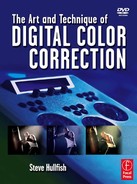Book Description
Provides direct access to the skills, insights and techniques of some of the postproduction industry's most prominent digital video colorists, delivering practical skills to the postproduction pro seeking to improve their color grading craft. The author interviews and observes 8 professional colorists as they grade a series of real world video images, describing the methods and techniques each artist uses to reach their finalized image. These video images are included on a DVD that allows you to work lockstep with each artist as they grade their images.
Though some tools provided may differ from one product to the next, the basic process of video color correction (grading) remains the same. Application agnostic and sure to inspire, The Art of Digital Video Color Correction will further your artistic skills, whether you're an editor, compositor, or colorist, and allow you to apply those skills to the grading process, making your finished image sharper, crisper and more aesthetically pleasing in general.
Table of Contents
- Front Cover
- Title
- Copyright
- Contents
- Acknowlegments
- Introduction
- Primary Color Correction
- Chapter 1 Tonal Range Primer
- Monitoring
- Video Monitor
- Viewing Environment
- Surround Environment: Interview with Randy Starnes
- Waveform Monitors and Vectorscopes
- Alternative Displays and Tools for Analysis
- First Things First: Black Level
- Setting Highlights
- Setting Gammas or Midtones
- Defining Contrast
- Practice Playing Gamma Against Highlights and Shadows
- Chapter 2 Tonal-Correction Tools
- Main Tools for Tonal Corrections
- Sliders and Numerical Controls for Tonal Range
- Don’t use Brightness or Contrast Controls
- Color’s Primary In Room
- Avid Symphony and Color Finesse HSL Controls Tab
- Histograms or Levels
- Histograms
- Forms and Functions of Histograms
- Curves Tab
- S Curve Tip
- Curves Tutorial
- Isolating Tonal Ranges with Curves
- Luma Range Display
- Luma Range Editing
- Alternative to Luma Range
- Chapter 3 Color Control Primer
- Balancing an Image
- Analyzing Color Casts
- Using Your Eyes
- Color and the Waveform
- Color and the Vectorscope
- Histograms
- Eyedropper
- Balancing Color with a Flat-Pass Waveform Monitor
- Color Contrast
- Chapter 4 Color Control Tools
- Hue Offset Wheels or Color Balance Controls
- Hue Offsets with RGB Parade
- Saturation Controls
- Histograms
- Curves
- RGB Setup, Gamma, and Gain Sliders
- Channels
- Printer Lights
- Filters
- Conclusion
- Secondary Color Correction
- Chapter 5 Secondary Color Correction Primer
- The Purpose of Secondary Correction
- Are You Qualified?
- Color Vector Isolation
- Isolating a Vector in Final Cut Pro
- Isolation Practice
- Spot Color Correction (Vignettes or Power Windows)
- Vignette
- Geographical Color Fix
- User-Defined Shapes
- Using Spot Color Correction to Relight
- Color Vector with Garbage Matte
- Color’s Secondary Curves
- Secondaries Are Crucial
- Chapter 6 Secondaries with the Pros
- Vignettes
- Vignetting the Ultralight Flyover Scene
- Vignetting the Kiss Me in the Dark Bedroom Scene
- Spot Color Correction
- Vignette to Create Day-for-Night Shot
- Vector and Luma Qualified Secondaries
- Secondary Corrections Can Focus Attention
- Using Secondaries to Match
- Using a Luma Key to Build Contrast
- Pro Colorists
- Chapter 7 Correcting Shots
- Three More Grades of the “Banker’s Light” Scene
- Saving a Shot with Bad Color Cast
- Four Trips Down the “Alley”
- Three Passes Over the Barn
- Building Up a Weak Piece of Video
- Using Many Tools to Fix a Shot
- Grading with Curves in Primary
- Chapter 8 Telling the Story
- Color Changes the Story
- Talk like a Director of Photography
- The Story Is the Script
- Emphasize Elements to Further the Story
- Imposing a Story on the Boxer
- Conclusion
- Chapter 9 Matching Shots
- Matching the Lions of the Art Institute
- Matching Scene to Scene
- Matching When Lighting Changes in a Scene
- Conclusion
- Chapter 10 Creating Looks
- Enough is Enough
- Preset Looks
- Festa’s PowerGrade Library Revealed
- Preset Looks in Apple’s Color
- Film Processing Looks
- Skip Bleach or Bleach Bypass
- Match the Look
- Looks for Promos and Opens
- True Grit
- Graphic Looks
- Day-for-Night
- Chapter 11 Miscellaneous Wisdom
- Starting Off
- Communicating with Clients
- Taking It to Extremes
- The Importance of Color Contrast
- Maintaining a Look
- Looking at Real Life for Inspiration
- Multitasking
- Smoke
- Keeping Butts in the Seats
- The Future of Color Correction
- Books of Note
- Conclusion
- Index
